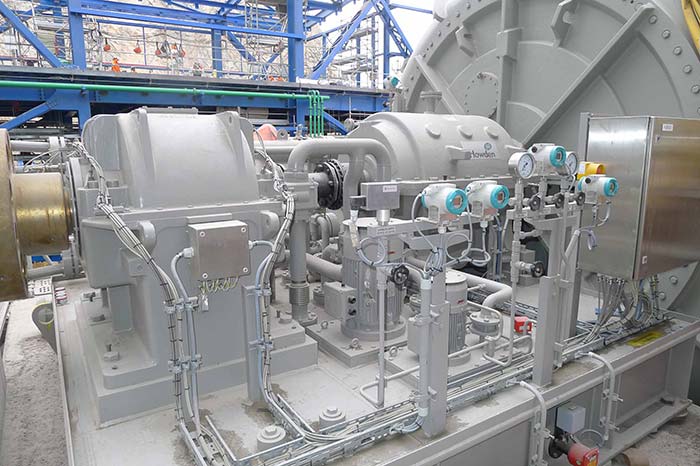RISKS vs RELIABILITY - CENTRIFUGAL COMPRESSORS

ADVANTAGES - RISKS
ADVANTAGES - RELIABILITY
Here are some potential advantages of using the concept of risks instead of reliability when dealing with centrifugal compressors in the engineering and design phase or during operation and maintenance:
Identification of critical failure modes: A risk-based approach can help identify the most critical failure modes for the centrifugal compressor, allowing for focused attention on those areas during design, maintenance, and operation.
Cost-effective solutions: A focus on risk can help prioritize the allocation of resources towards the most critical areas, allowing for cost-effective solutions to be implemented to mitigate the identified risks.
Increased flexibility: A risk-based approach can help identify potential failure modes and risks associated with changes to the operating conditions, allowing for more flexible and adaptable equipment that can withstand changes in conditions.
Early detection and prevention: A risk-based approach can help identify potential failure modes before they occur, allowing for early detection and prevention of failures, reducing the likelihood of unscheduled shutdowns and improving overall reliability.
Optimization of maintenance activities: A focus on risks can help prioritize maintenance activities based on the criticality of the failure modes, resulting in more efficient and effective maintenance activities that improve the overall reliability of the equipment.
In summary, a risk-based approach can provide several advantages when dealing with centrifugal compressors in the engineering and design phase or during operation and maintenance. These advantages include the identification of critical failure modes, cost-effective solutions, increased flexibility, early detection and prevention of failures, and optimization of maintenance activities.
Here are some potential advantages of using the concept of reliability instead of risks when dealing with centrifugal compressors in the engineering and design phase or during operation and maintenance:
Emphasis on long-term performance: A reliability-based approach prioritizes long-term performance and reliability over short-term solutions, ensuring that the equipment operates safely and reliably over its entire useful life cycle.
Proactive approach to maintenance: A reliability-based approach focuses on proactive maintenance activities, such as condition-based maintenance, to identify potential issues before they become critical and cause unscheduled shutdowns.
Consideration of overall system reliability: A reliability-based approach takes into account the reliability of the entire system, including the interactions between various components and the impact of operational and environmental conditions, ensuring that the system operates reliably as a whole.
Quantitative analysis of equipment performance: A reliability-based approach involves quantitative analysis of equipment performance, allowing for more accurate predictions of equipment reliability and performance, and more informed decision-making regarding maintenance and replacement.
Continuous improvement: A reliability-based approach involves continuous monitoring and improvement of equipment reliability and performance, ensuring that the equipment continues to operate safely and reliably throughout its entire useful life cycle.
In summary, a reliability-based approach can provide several advantages when dealing with centrifugal compressors in the engineering and design phase or during operation and maintenance. These advantages include an emphasis on long-term performance, a proactive approach to maintenance, consideration of overall system reliability, quantitative analysis of equipment performance, and continuous improvement of equipment reliability and performance.

DISADVANTAGES - RISKS
DISADVANTAGES - RELIABILITY
Here are some potential disadvantages of using the concept of risks instead of reliability when dealing with centrifugal compressors in the engineering and design phase or during operation and maintenance:
Limited consideration of long-term reliability: A risk-based approach may prioritize short-term cost savings or risk mitigation strategies that may not address long-term reliability concerns, resulting in increased downtime and costs in the future.
Overemphasis on worst-case scenarios: A risk-based approach may overemphasize worst-case scenarios and potential failures, leading to over-engineering or unnecessary maintenance activities that may not be cost-effective or necessary.
Difficulty in accurately quantifying risks: A risk-based approach relies heavily on accurate risk assessments, which can be challenging to develop due to the complex nature of equipment and the potential for unknown or unforeseen factors to impact equipment reliability.
Inadequate consideration of human factors: A risk-based approach may not adequately consider human factors such as operator error, inadequate training, or other organizational factors that can contribute to equipment failures.
Lack of standardization: A risk-based approach can result in inconsistent risk assessments and mitigation strategies due to the lack of standardization in risk assessment methodologies and terminology.
In summary, a risk-based approach may have some potential disadvantages when dealing with centrifugal compressors in the engineering and design phase or during operation and maintenance, including limited consideration of long-term reliability, overemphasis on worst-case scenarios, difficulty in accurately quantifying risks, inadequate consideration of human factors, and lack of standardization.
Here are some potential disadvantages of using the concept of reliability instead of risks when dealing with centrifugal compressors in the engineering and design phase or during operation and maintenance:
Limited focus on critical failure modes: A reliability-based approach may not prioritize the identification and mitigation of critical failure modes, which can lead to unscheduled shutdowns and increased downtime.
Costly maintenance activities: A reliability-based approach may result in costly maintenance activities, such as scheduled replacements or overhauls, that may not be necessary if the critical failure modes were identified and addressed through a risk-based approach.
Lack of flexibility: A reliability-based approach may not take into account changes in operating conditions or other factors that can impact the reliability of the equipment, which can result in unexpected failures and increased downtime.
Over-reliance on statistical analysis: A reliability-based approach often involves statistical analysis and predictions of equipment performance, which can be inaccurate if the underlying data or assumptions are incorrect.
Neglect of human factors: A reliability-based approach may focus solely on the technical aspects of equipment reliability and maintenance, neglecting human factors such as operator error or inadequate training, which can also contribute to unscheduled shutdowns and equipment failures.
In summary, a reliability-based approach may have some potential disadvantages when dealing with centrifugal compressors in the engineering and design phase or during operation and maintenance, including limited focus on critical failure modes, costly maintenance activities, lack of flexibility, over-reliance on statistical analysis, and neglect of human factors.
